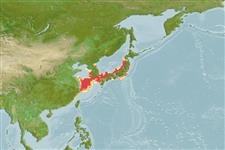Teleostei (teleosts) >
Gobiiformes (Gobies) >
Gobiidae (Gobies) > Gobionellinae
Etymology: Chaeturichthys: Greek, chaite = hair + Greek, oura = tail + Greek, ichthys = fish (Ref. 45335); jeoni: Named for Sang-Rin Jeon, Professor Emeritus of Sang Myung University, Seoul..
Environment: milieu / climate zone / depth range / distribution range
Ecology
Marine; demersal; depth range 11 - 110 m (Ref. 93271), usually 43 - 85 m (Ref. 93271). Subtropical
Western Pacific: Bohai Sea to East and South China seas.
Size / Weight / Age
Maturity: Lm ? range ? - ? cm
Max length : 22.0 cm SL male/unsexed; (Ref. 93271)
Short description
Identification keys | Morphology | Morphometrics
Dorsal spines (total): 8 - 10; Dorsal soft rays (total): 20 - 22; Anal spines: 1; Anal soft rays: 18 - 20. This species is distinguished from its only congener, C. stigmatias, by having the following characters: interorbital space scaleless (vs. embedded scales); usually 4 pairs of barbels on ventral surface of head, with 3 pairs of long barbels and a pair of short one (vs. usually 3 pairs of long barbels only); pectoral-fin rays 22-25, modally 24 (vs. 21-23, modally 22); most of pectoral-fin rays are branched, not forming free rays (vs. ventral 3-5 rays of pectoral fin simple, forming free rays); longitudinal scale rows 50-58 (vs. 47-53); transverse scale rows 20-25 (vs. 17-21); predorsal scales 23-29 (vs. 20-22); gill rakers on outer surface of first gill arch 2-6?9-13?12-16 (vs. 4-6 + 11-14 ? 16-19); pseudobranchial filaments 7-13, usually 9-11 (vs. 6-8, usually 7); preopercular canal with pores M' and N' (vs. only with pore N'); longer snout, its length 7.7-10.0% of SL (vs. 6.1-8.1% of SL) (Ref. 93271).
Collected from the continental shelf of East Asia between the Bohai Sea and South China Sea (Ref. 93271).
Life cycle and mating behavior
Maturities | Reproduction | Spawnings | Egg(s) | Fecundities | Larvae
Shibukawa, K. and A. Iwata, 2013. Review of the East Asian gobiid genus Chaeturichthhys (Teleostei: Perciformes: Gobioidei), with description of a new species. Bull. Nat. Mus. Nat. Sci. Ser. A., Suppl. 7:53-66. (Ref. 93271)
IUCN Red List Status (Ref. 130435)
Threat to humans
Harmless
Human uses
Tools
Special reports
Download XML
Internet sources
Estimates based on models
Preferred temperature (Ref.
123201): 8.6 - 21.9, mean 16.8 °C (based on 70 cells).
Phylogenetic diversity index (Ref.
82804): PD
50 = 0.7500 [Uniqueness, from 0.5 = low to 2.0 = high].
Bayesian length-weight: a=0.00724 (0.00338 - 0.01553), b=3.05 (2.87 - 3.23), in cm total length, based on LWR estimates for this (Sub)family-body shape (Ref.
93245).
Trophic level (Ref.
69278): 3.7 ±0.5 se; based on size and trophs of closest relatives
Resilience (Ref.
120179): Medium, minimum population doubling time 1.4 - 4.4 years (Preliminary K or Fecundity.).
Fishing Vulnerability (Ref.
59153): Low vulnerability (17 of 100).
